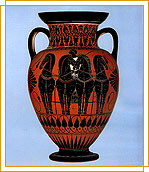Rules of the equestrian events
The horse races that took place in Olympia included: the keles, a race for full-grown horse with a rider (horse should be one year old), which was included in 648 BC, the kalpe, a race for mares in 496 BC, and the race for foals in 256 BC. the kalpe, a race for mares in 496 BC, and the race for foals in 256 BC.
The chariot races had their origin in the military customs of the Achaeans. The following is a list of chariot races in the chronological order in which they appeared in Olympia: the tethrippon, a four-horse chariot in 680 BC, the apene, a chariot pulled by two mules in 500 BC, the synoris, a chariot pulled by two horses in 408 BC, the tethrippon for foals in 384 BC and the synoris for foals in 268 BC.
The Hippodrome was a wide, flat, open area where the starting and finishing line was defined by a pole. A second smaller pole, the nyssa, defined the turning point, a dangerous point where many accidents took place. The track itself was divided with a stone or wooden partition, called embolon, next to which the horses and chariots run. It is known that the tethrippon completed twelve rounds of the track (the poet Pindar called this contest dodekadromon). The synoris and the tethrippon for fowls were eight-round races while the synoris of fowls was a three-round race. We know very little about the rules of the equestrian events. It is known that someone could not swerve in front of the other competitors, except if he was too far away from those behind him, so that collisions would be avoided.
At Olympia, opposite the nyssa, there was a round altar, the Taraxippos, which created havoc among the horses. Possibly, this was related to the position of the sun, since the games started in the afternoon at the time when the sun was setting and during the turn the animals were blinded by the glare resulting in many accidents.
Pausanias described in detail the complex system for the starting of the race, the hippaphesis, the invention of the statue-maker Kleoitas. On the western, narrow side of the hippodrome, the starting positions were in the shape of a triangle with a bronze dolphin on a high pole at its apex. In the middle of the basis of the triangle there was a stone altar with the starting mechanism. The altar was decorated on its uppermost part by a bronze eagle. Right before the contest, the chariots entered into the special partitions. With the sound of the trumpet, the eagle of the altar was raised, so that the spectators could see it, the dolphin fell on the ground and the rope was removed from the positions -starting from the two flank ones- so that all chariots should be positioned on a straight line.
The chariot was a small, wooden vehicle, wide enough for two standing men and open at the back. It was supported on a thill, whose edges were fastened on two powerful, wooden wheels. The stronger and faster animal was placed on the right to facilitate the chariot during turns. The horses were marked at the hoofs or the thighs, either with the letter q (koppa), from which they took the name koppaties, or with the letter ó, from which they took the name samphores. Even though the original war chariot was for two men -the charioteer and the warrior- the tethrippon and synoris carried only the charioteer.
|
